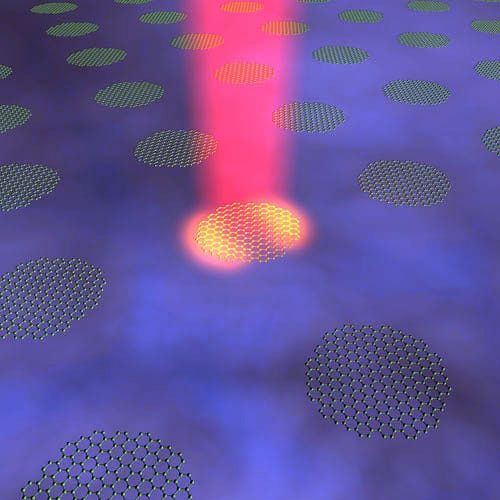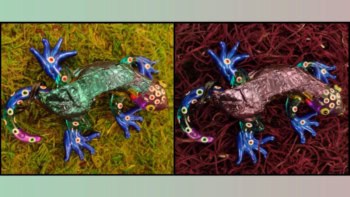
Physicists in Spain and the UK have calculated that graphene – a layer of carbon just one atom thick – could be used to create a perfect absorber of light if it is doped and patterned into a periodic array. The work could lead to improved light-detection devices, particularly in the infrared part of the electromagnetic spectrum, where current technologies struggle to function.
The claim is extraordinary because conventional materials normally need to be thousands of atoms thick to absorb light completely. “The prediction that a material layer only one atom thick can completely absorb light is remarkable and exciting,” says team leader F Javier García de Abajo of the Institute of Optics in Madrid.
“The layer in question is graphene patterned into a periodic array of nanodiscs,” explains García de Abajo. The structure absorbs light by confining it to regions that are hundreds of times smaller than the wavelength of the light. This is done by exploiting plasmons that occur within the individual nanodisc structures. Plasmons are quantized collective oscillations of the electrons within a nanodisc – and they interact strongly with light.
Doping with electrodes
Light confinement in graphene is possible only if the material is electrically charged. And the wavelength at which light can be confined and absorbed depends on how much the material is charged. Also known as doping because it has an effect similar to that of introducing impurities to conventional semiconductors, charging is easily achieved by placing electrodes near the graphene. The amount of charging itself can then be controlled by varying the voltage applied to the electrodes.
In their calculations, the team studied how the patterned graphene absorbed light in the near- to mid-infrared range of the electromagnetic spectrum. The researchers say that it would be easy to extend their results to other wavelength ranges, towards the mid-infrared and the terahertz regime, for example, by directly applying the analytical equations that they employed. “All of these spectral regions are especially interesting, with potential applications in imaging, sensing and detection,” says García de Abajo. “We are in need of good light-absorbing devices in this range of wavelengths because existing detectors perform poorly here. Our work may even provide a way to bridge this infamous ‘terahertz gap’.”
Separation is just right
The researchers say that the nanodiscs are able to absorb large quantities of light because these individual graphene structures are arranged at a well defined distance from each other. If they are too close, the light can be re-emitted back and can be reflected. On the other hand, it is insufficiently absorbed if the nanodiscs are placed too far apart. A similar effect can also be obtained with other graphene patterns, specifically with ribbons, which the researchers say are easier to dope.
The light also produces induced fields near the nanodiscs. These fields are made up of evanescent waves – electromagnetic waves that decay exponentially away from a structure. “The mechanism is therefore not a diffraction effect in the classical wave sense in which two or more propagating waves interfere and form patterns limited in size to about half the wavelength of light,” explains García de Abajo. “It instead involves critical coupling.”
The team, which includes scientists from ICFO in Barcelona and the Optoelectronics Research Centre at the University of Southampton, now plans to explore other extraordinary optical effects in graphene – possibly down to the quantum limit with studies on the effects of single photons. “We also hope to analyse alternative materials, such as topological insulators, that might produce similar effects,” reveals García de Abajo.
The work is described in Phys. Rev. Lett. 108 047401.



